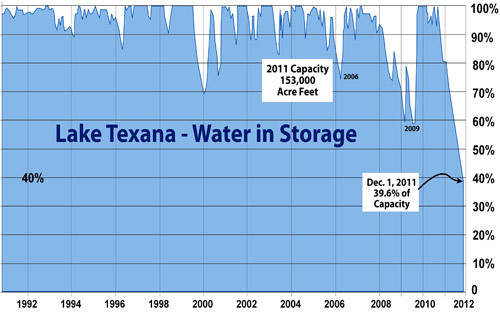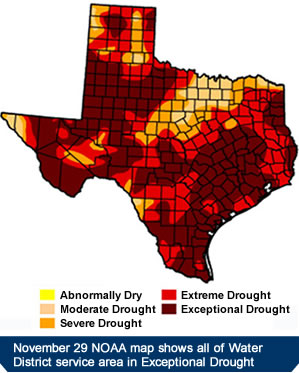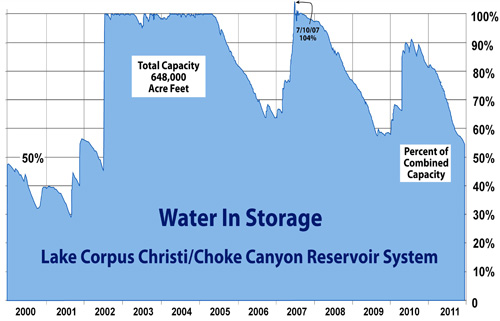
December 7, 2011
With virtually no water inflows from the Navidad River and other tributaries in the past year, Lake Texana water levels are now below 40% of capacity. This is the lowest level since the reservoir became fully operational in the mid 1980s.
About one half of the raw water used by the San Patricio Municipal Water District (SPMWD) to supply municipal and industrial customers comes from Lake Texana which is located 110 pipeline miles to the northeast in Jackson County.
Customers depending on Lake Texana include the City of Point Comfort, the Formosa Plastics Corp. complex at Point Comfort, Inteplast Group at Lolita, Corpus Christi, South Texas Water System and the SPMWD. Customers in the Point Comfort area have no alternative water supply. The Lavaca-Navidad River Authority has informed customer in the Point Comfort area that all water diversions from the lake will be reduced by 20% with lake levels below 40% of capacity. Texana capacity dropped below 40% at the end of November.
At the direction of the SPMWD Board of Director notices were sent to the District’s wholesale customers in November expressing the board’s concern about the rapid drop in the water level at Lake Texana. If the District is required to reduce the amount of water received from Lake Texana the result will be that a higher percentage of raw water must come from the Nueces River and the Lake Corpus Christi/Choke Canyon Reservoir system.
The dissolved mineral content, including chloride, in the Nueces River water is much higher than water from Lake Texana and will provide operational challenges in the water treatment process and for industrial customers using the water for process and cooling purposes.
The Water District staff began work in late summer to implement raw water system modifications that will allow a shift to a higher percentage of water from the Nueces River in case Lake Texana water is not available. The District is buying a new large pump for the Edwards Pump Station that will serve as a backup to a critical 500 horsepower unit that draws water from the river and pushes it uphill through a 36-inch line from near sea level to a raw water booster station located south of Odem at an elevation of 70 feet. The District is reactivating and upgrading the raw water booster station which has been off line since the District started taking water from Lake Texana via a connection to the Mary Rhodes Pipeline in 1999. These drought contingency measures will have a total cost of approximately $200,000.
Minimal inflows, very high evaporation rates and high demand from customers served by the regional system have steadily lowered the amount of water in storage at Lake Corpus Christi and Choke Canyon this year. Total storage for the sysem slipped below 55% of capacity in early December.
EXTREME DROUGHT
There have been small, scattered rainfall events this fall with frontal passages but it has made no significant impact on the "exceptional" drought status across the area. Burn bans remain in effect for the entire region and fires in dry vegetation continue to be a problem.
Most of Texas remains in an extreme drought which started in the fall of 2010 and is showing no signs of relenting. Weather forecasters say that with La Niña locked in place the drought conditions will persist at least through May.
Every La Niña on record since 1900 has resulted in below-normal rainfall for the Southwest U.S. November through March are among the driest months of the year in Texas even in a typical year.
WATER MANAGEMENT
The City of Rockport has a standing request for customers to voluntarily cut their water use to stay within delivery system capacity. Other customer cities served by the Water District will likely soon have to make a request for greater voluntary conservation by customers.
By contract Water District customers must comply with the Drought Management Plan adopted by the City of Corpus Christi which manages the region’s water supply system. The plan is tied to the combined amount of water in storage in Choke Canyon and Lake Corpus Christi. It has triggers at 50%, 40% and 30% of capacity. When the reservoir system storage drops below 50% of total system capacity, the local water provider will issue a public notice to inform water users to take greater voluntary conservation measures.
When capacity drops to 40% water providers will implement mandatory restrictions including time of day outdoor watering restrictions. Residents and businesses will be restricted from using water for irrigation of vegetation between the hours of 10:00 a.m. and 6:00 p.m. Under the 40% restrictions no person may: (1) allow water to run off from yards or plants into gutters or streets, (2) allow defective plumbing in a home or business to remain unaddressed or (3) allow water to flow constantly through a tap, hydrant, valve, or otherwise by any user of water connected to the municipal system.
At 30% of reservoir capacity residential lawn watering will be sharply restricted to specific days in an effort to reduce demand further.









